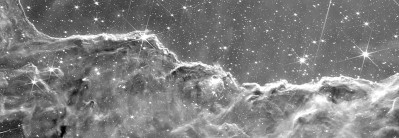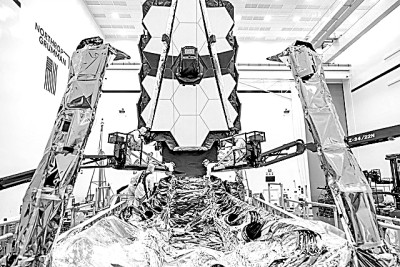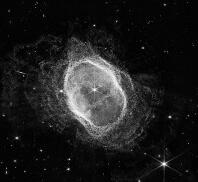Waobo Space Telescope's Star Guanzi
Author:Guangming Daily client Time:2022.08.04

Cosmic images shot by James Wob Space Telescope. Xinhua News Agency

James Wabo Space Telescope. Data picture

James Wob Space Space Telescope Drama diagram. Guangming Picture/Vision China

Cosmic images shot by James Wob Space Telescope. Xinhua News Agency
A few days ago, a group of special photos attracted people's attention: the beautiful bottom of the ship, the "Nantian Ring" Nebula, the "Stephen Five Powder" galaxy, the SMACS 0723 galaxy group ... It is the most advanced space astronomical device of human beings, James Webb Space Telescope.
What is Weibu?
A huge "cosmic camera"
The first time I saw the James Wabo Space Telescope (JWST, hereinafter referred to as Webb), I might feel very surprised -aside from the huge volume, it is not discussed. The strange purple -pink film seems to be far away from the telescope we touch in peace.
In fact, Weibu is like a "cosmic camera": main mirrors, secondary mirrors, etc. are equivalent to "lens" without lens barrels, while other parts are equivalent to "body". The golden hexagonal panel is its main reflex mirror. Its diameter is 6.5 meters and is stitched from 18 hexagonal sub -mirrors. The reason why it is designed into a splicing is because it is too large, it must be folded before it can be placed in the rocket's cabin room.
Such a huge mirror is exactly where Weibu's science is. The law of optics tells us that the greater the caliber of the telescope, the higher the efficiency of capture of photons. The photon emitted by the celestial bodies seems to be a raindrops in the rain, and the larger telescope diameter is like using a larger bucket to connect the rainwater. In a short period of time, it can produce high brightness images, thereby seeing those distant and dull celestial bodies. In addition, the larger -caliber mirror also has higher resolution, and the image obtained is clearer. In this way, the celestial bodies we have taken have richer details.
It is not easy to complete a "space origami". Each sub -mirror of Weibu is made of metal tadpoles, light and solid; a layer of extremely thin gold is plated, which effectively reflects infrared light and is not easy to dim. In addition, each side mirror can freely change the curvature and direction. After calibration, they will form a huge parabolic surface together to gather the starlight on the auxiliary mirror. In order to synthesize the perfect parabolic surface, after the opening of the space, the micro -mechanical motor must seamlessly alternate each sub -mirror, and the error cannot exceed one tenth of the diameter of the hair wire. The difficulty can be imagined.
After layers of reflection, the starlight enters the "Scientific Instrument Module" behind the main mirror in the center of the main mirror, where further conversion and processing is obtained. Webu carried four terminal scientific instruments, which were MiRI, near -infrared cameras, near -infrared imagingers and seamless spectrums (NIRISS), near -infrared spectrums (NIRSPEC). Among them, medium infrared instruments can work within the wavelength range of 5-28 microns, while three instruments nearly infrared work within the wavelength range of about 0.6 to 5 microns. In comparison, the range of light wavelengths seen by human eyes is only about 0.4 to 0.8 microns, and it is much limited.
Like ordinary cameras, Chinese infrared instruments and near -infrared cameras can shoot images, but their sensitivity is much higher than that of commercial cameras and even military satellites. They can detect the traffic as low as Gunangsky. Assuming that a child's bedside night light opened on the moon when he sleeps, from the ground. Twenty times!
Before reaching the camera negatives, the starlight will pass through the filter wheel, and more than ten different filters are settled on the wheels. These filtering filters each allow the light of the specific wavelength range to pass, and the front film can be rotated according to the computer instruction. In this way, every picture taken by astronomers only reflects the radiation of celestial bodies within a specific wavelength range. Take photos under different filters, you can know the radiation distribution of the celestial body in each wavelength, thereby inferring the nature of the celestial body. Give the photos of different filters in the computer to give a single color respectively, and then superimposed to get the colorful astronomical photos we often see. In addition, Webu is also equipped with a star corona. It can cover the bright celestial body, so that the dim background around the celestial body appears.
But in addition to shooting images, astronomers are even more looking forward to obtaining the spectrum information of the celestial body with Wabbu. Multi -color light like sunlight is scattered through the water vapor in the atmosphere, and a gorgeous rainbow will be produced. The distribution of light is called a spectrum according to the wavelength (or frequency). Webu's four instruments can be shot by spectrum. Atoms and molecules absorb or emit specific wavelengths of light will be reflected on the spectrum. Through the spectral spectrum, we can know the type, speed, distance, composition and other important information of the celestial bodies, so as to draw the "three -dimensional map" of celestial bodies in the universe.
Why cost $ 8.8 billion?
Make sure that Webu takes the best photos
In December 2021, the Webu Telescope took the Ariana No. 5 Rockets and lift off at the launching ground of French Guyana.
This is an appointment that has been late for 14 years. Before the launch of Hubble Space Telescope (HST, hereinafter referred to as Hubble), astronomers began to consider building a more powerful space telescope, called "the next generation of Space Telescope (NGST)". The initial plan was to cost $ 500 million to build a 8 -meter -caliber telescope and launch in 2007. However, the project has repeatedly expanded and extended. By the final launch of the Webb Mirror, the total investment had exceeded 10 billion US dollars. Webb's extension is mainly based on safety considerations. There are countless precedents for the fault of the space telescope. For example, after Hubble was launched in 1990, astronomers were shocked that the images it took was very vague: the shape of the lens grinding was wrong, and there was no way to accurately focus on the light! It wasn't until 1993 that the astronauts drove the spacecraft to space and installed a "myopia glasses" for Hubble to return to normal. Hubble runs around the near -ground track, and it can be remedied after wrong; Four times the distance between the earth. In case Wabu fails, human beings cannot repair it in person within the entire "life" (expected life expectancy for more than ten years). Therefore, the team must be repeatedly inspected on the ground to ensure that it is foolproof.
Why launch a telescope at such a distance? The benefits of entering space are obvious: there is no longer restrictions on day and night, no rainy weather, avoiding the absorption of atmosphere and reflecting the starlight ... But the earth is always exuding the calories equivalent to room temperature, which will allow the aerospace on the near -ground track The temperature of the device rises. It is a big interference for infrared detectors such as Webb.
All objects will emit infrared rays. Since the epidemic of new crown pneumonia, we may be accustomed to seeing ourselves in infrared photos -the body temperature imaging instrument of public places is the most common application of infrared cameras. The human body will emit infrared, as well as the solar, earth, distant stars and galaxies. What's even more wonderful is that infrared rays can also penetrate the cover. There are a large amount of particles permeated in the galaxy, called "interstellar dust", which will block ultraviolet rays and visible light, but infrared rays are unimpeded. Therefore, the use of infrared to observe the unique advantages of the dust area, and you can see the glowing celestial body behind the dust.
In addition, the extremely distant galaxy and galaxy media will produce the so -called "red shift". The Doppler effect tells us that once the object is on the other hand with the observer, the wavelength that the observer sees will become longer. According to the theory of expansion of the universe, the distant celestial bodies are away from us. In this way, their radiation will move to the red end of the spectrum as a whole. The farther the celestial body, the faster the speed away from us, and the greater the red shift. In the distant galaxy, a large part of the energy was originally emitted in the visible light wave segment. After the red shift, this part of the energy is just in the infrared band of Webb detection. Therefore, Weibu is also very suitable for detecting the most distant celestial bodies.
However, after all, the Wabe telescope is in the solar system, and it is inevitable that the sun is inevitable. If the temperature of the mirror is too high, the infrared rays produced by themselves will also interfere with observation. To this end, Webu is equipped with two passive and active cooling methods.
In the direction towards the sun, Weibu supported a "parasol" -the large polytamine film as a tennis court. This material is less than one millimeter thick, not only lightweight, but also to withstand a large temperature difference. The film has five layers, and aluminum is placed on each layer, which can reflect and isolate the heat. On the front two layers facing the sun, pink doped silicon coatings were also covered, and the cooling efficiency was greatly improved.
On the side of the film towards the sun, the temperature is as high as 110 degrees Celsius; and after the five layers of film barrier, the side of the back to the sun drops below minus 230 degrees Celsius. The "sunscreen index" of our commonly used skin creams or parasols is only about 50, but Weibu's parasol "sunscreen index" reached 1 million, which means that only one -million -dollar "leakage fish".
However, the instruments in the scientific instrument module are extremely sensitive to temperature, and it is not enough to rely on passive cooling. For example, medium -infrared instruments need to work at minus 266 degrees Celsius to work normally (only 7 degrees higher than absolute zero). At this time, the "low -temperature cooler" is required. In addition to the advanced cooling mechanism, it may be the most "mute" refrigerator in the world -because even a little vibration, it will cause disaster -like images to blur.
What do Weibu do?
Deepen people's understanding of the universe
As the most expensive, largest, and most advanced space telescope, Weibu's main mission is classified as four fields: cosmic dawn and recreation, galaxies, star and original planet system, planetary system and life origin.
First of all, the infrared band is suitable for observing those distant celestial bodies. An important task of Weibu is to understand the early history of the universe. The speed of light is limited, and it takes time to pass through the distant distance. The sunlight takes 8 minutes to reach the earth, so what we see on the earth is the sun 8 minutes ago; the light emitted by the neighboring galaxy takes tens of thousands of years to reach the solar system. What we see is what they look like thousands of years ago. In this sense, the universe is like a time exhibition hall: the farther we see, the older the exhibits we see.
The near -neighboring galaxy we usually observe is basically below 0.1; red movement 2 to 3 is called a high -red shift galaxy by astronomers, which is quite difficult to detect. And Weibu is expected to see the original galaxy of the red movement close to 20. They are extremely far away. The light observed by Weibu was issued when the universe had just been born for less than 200 million years. In the first batch of data released by Webbu, astronomers have detected galaxies with red movement of about 10. The deeper points are expected to be traced back to the period of the universe, which is the first ray of dawn in the universe. Secondly, Webu can directly see the huge dust clouds in the galaxy, and these clouds are opaque to optical telescopes such as Hubble. The stars including the sun are formed by the collapse of such a nebula, but we have not yet understood its specific process. Not only that, Weibu can even directly see the original star disk in the process of planet formation, so that we can better understand the formation of the original planetary system.
Again, Webb has amazing resolution and sensitivity, so when it looks at those closer galaxies, it will reveal the abnormal form and spectrum information of the details. We already know that galaxies are divided into several types, and their composition is different, and there is a evolutionary relationship between each other. Obtaining a large number of galaxy data through the sky patrol, Weibu is expected to answer a series of key questions. For example, how the black hole affects the form of the host galaxy and galaxy, and how chemical elements are distributed in the galaxy ...
In the end, whether there is other life in space is also the focus of Wabbu. When the external planet passes from the mother star, the specific elements in the atmosphere will absorb the light from the mother star. Weibu detects this absorption spectrum, and you can know the atmospheric components of the outer planet. In the first batch of photos, astronomers have proved that a water molecule has a planet. One day, we may detect more "biological marks" -such as methane, oxygen, etc., such as methane, oxygen, etc. Webu will also investigate the celestial bodies in the solar system: comets, asteroids, ice satellites, etc. We are familiar with our "neighbors", and we will have a deeper understanding of our origin.
During the same period as Webb, China's space astronomy is also booming. The "Goku" dark object particle detection satellites, "Huiyan" hard X -ray modulation telescope satellite, etc. have achieved excellent results. A number of advanced equipment such as the China Space Station Engineering Telescope and Einstein probe satellite are also planning. However, we have no our own infrared astronomical satellites so far, and we have a certain gap at the level of talent reserves, infrared detectors, and design decisions.
If the universe is compared to a treasure trove, Webu's first photo is just a glimpse of standing at the gate. In the next space journey, Weibu will show more treasures of the universe to humans. We also hope that one day we can see China's own infrared space telescopes soaring the sky and invest in our eyes to our eyes.
(Author: Liu Fengyuan, a graduate student of the National Observatory of the Chinese Academy of Sciences)
- END -
Su Daguang Electric Schools realize efficient and stable Micro LED driving circuit technology breakthrough
Micro-LED, also known as micro-luminous diode, has the advantages of high resolution, low power consumption, high brightness, high contrast, fast response speed, long life and other advantages, so it
When a bee moves to the city, can humans "be good with neighbors"?

Speaking of bees, do you think of the beehive on the roadside or field? When the b...